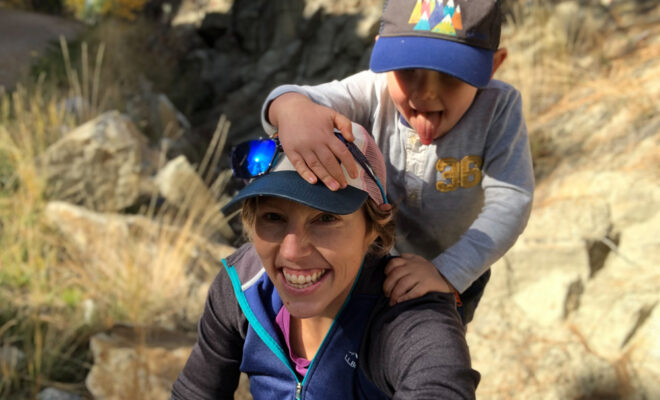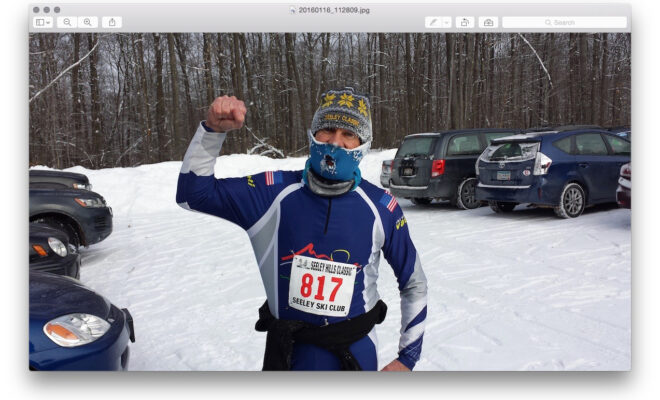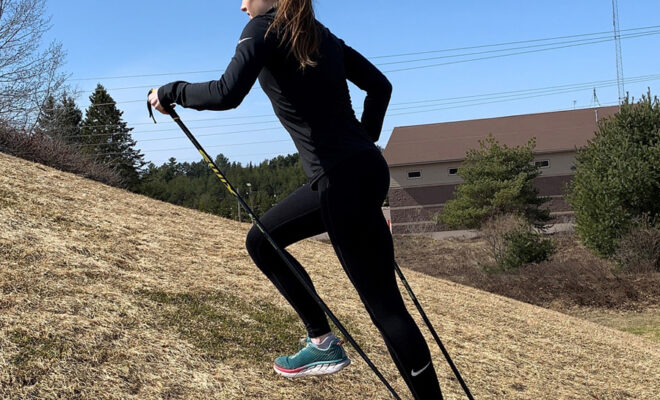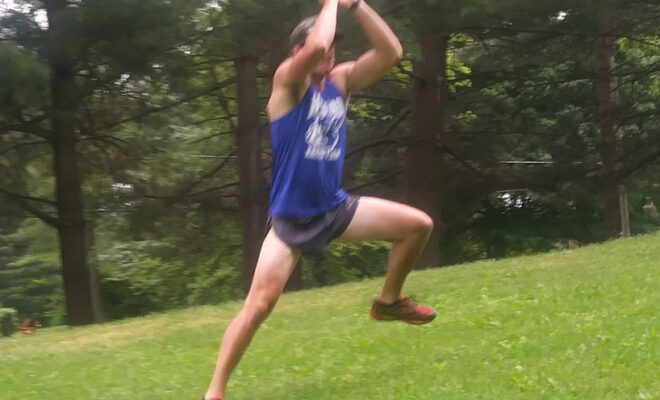Incorporating Strength Training in Season
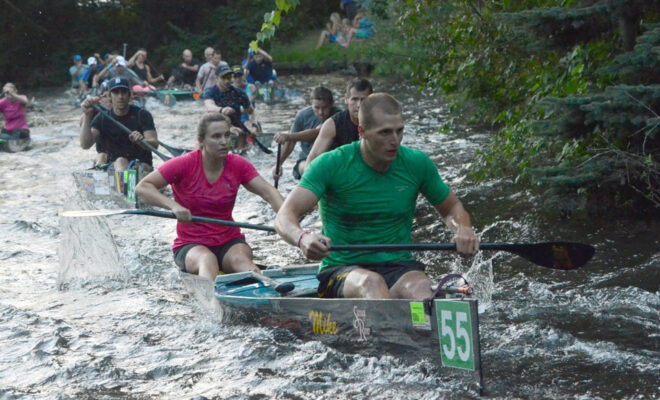
By Rebecca Davis
Editor’s Note: Rebecca Davis, a marathon canoeist, also enjoys cross-country skiing, running, yoga, camping, and hiking. With partner Edith MacHatttie, she holds the women’s course record in the 120-mile AuSable River Canoe Marathon, with a time of 15:15:36. Rebecca has completed the North American Birkiebeiner three times, with a best finish of 10th place in the 55km Classic. When she isn’t racing, she enjoys training with her husband, Mike, reading, and working on her family’s farm in Southern Michigan.

Members of the Michigan Canoe Racing association, Rebecca and Mike Davis, in lead canoe, compete near the start of the AuSAble River Canoe Marathon. Strength and aerobic fitness combined. Photo by Caleb Casey.
For most silent sports athletes, the focus is on enjoying the outdoors through endurance activities. The goal is to go longer, farther, and, if we can, faster. Only a handful of athletes participate in sprint-specific activities, while the rest tend to congregate around long races and even longer trips, whether biking, skiing, hiking, or paddling.
Maintaining strength is important for longevity in sport, injury prevention, and quality of life as people age. Doing full body movements will help maintain strength, bone density, and posture. Age-related declines will still happen, but the curve can be flattened, and a better quality of life made possible into advanced years.
We also know that incorporating strength training improves our silent sports performance. However, it isn’t always easy to implement a program or strategy. In addition to our preference for the outdoors that takes us away from the gym, if the plan also includes racing a full season of endurance events, where does strength training fit in to an already packed schedule?
Getting Started
It’s best to start small.
For older athletes especially, the idea of adding another workout when already fighting fatigue is daunting. With the drive to go farther, faster, longer, there is a tendency to over-train. Better practice suggests that strength activities should be incorporated as a replacement to a portion of the individual’s average weekly workload. For example, if you usually complete eight hours of dedicated endurance training each week, consider starting out by reducing a long, slow distance day by thirty minutes, and then incorporate three, ten-minute strength sessions instead.
With any strength training program, start by incorporating a few moves here and there, and then increase from there. You don’t need to strength train every day, and shouldn’t for muscle recovery purposes, and consider employing the 80/20 rule. That is, if you train five days a week, add strength-specific training to one of those days. It may not seem like much, but even one 20-minute session a week can make a huge difference in maintaining or building muscle.
Schedule this workout in advance, at a time when it’s easy for you to fit it in, to avoid procrastinating. This may be on a lighter training day, first thing in the morning, or during your lunch break. But make a commitment to yourself to follow through.
You may find it easier to take a class, or meet a buddy to keep you accountable. Just like any other type of training, don’t put off starting a program because you are afraid it won’t be perfect. Some strength training is better than none. Do focus on using good form and movements, as this will allow you to build without risking injury.
Taper for a Big Event
We want to build strength to supplement our main sport or sports, so don’t be afraid to adjust your training to fit where you are in your racing season. This means the majority of your strength training will probably happen in the off season, and then will taper as you get closer to your big events.
For example, if you were hitting the gym three times a week all winter, you should switch to twice a week in the early season while doing long, slow distance training, and then down to once a week during peak racing season.
After the biggest events of your calendar, give yourself time to recover, perhaps taking a week or two out of the gym.
Take a Whole Body Approach
Many competitors want to build muscles that correspond directly with their main sport. For example, bikers favor hips and legs, and less upper body work, whereas paddlers tend to sport built-up torsos and smaller legs. However, strength training only certain areas of your body is asking for muscle imbalances, leading to injury.
Don’t even think that you might build your leg muscles to bulky, inefficient weights by doing 5 minutes of squats and lunges each week.

Mike Davis, an elite aerobic athlete in his own right, proves that strength and aerobic training can be complementary forces. Here, Mike demonstrates proper form during a set of weighted squats. Proper form, regardless of weight amount, is a must. Especially with heavier weights, use safety equipment or a spotter, and guidance from a trained instructor. Photo courtesy of Rebecca Davis.
The same goes with upper body work. Five sets of 10 push-ups or pull-ups isn’t going to make you have the arms of the Hulk. Working the upper body, lower body, and core will help protect you against injury. Specifically, working the posterior chain will help with pain due to hamstring and glute weakness, which is common in anyone who spends a majority of their days seated.
Remember to do a bit of yoga or stretching. Encouraging flexibility will help improve posture, and is a good counter to repetitive motions. Strength and flexibility complement each other. More flexibility allows Olympic lifters to hoist more weight, and the same is also true in other disciplines.
Incorporate Strength in Sport
You may ask: If I taper my gym strength workouts as I go through my racing season, how do I keep from losing the power that I worked to develop?
The answer: Add specific activities to your water, trail, or road endurance workouts that promote explosive power. For example, intervals.
The most explosive intervals are going to be short and intense, fifteen seconds to one minute at anaerobic or near-anaerobic effort levels. In between intervals, rest for an equal or greater period. To get true strength building out of intervals, they should be relatively short in total duration, at least for those who are spending ten hours a week or less training. Go hard, create fatigue, and then recover.
You should feel definite muscle fatigue at the end of each interval, and the recovery period is necessary for you to put out another hard and effective effort. Doing intervals this way is similar to a high-intensity interval training workout you would get at a gym. Note that less intense aerobic intervals also have a place in your workout schedule, but they aren’t going to increase power as a strength session would.
Mark Your Achievements
As with any training, keep a log of what you do, and see if you achieve the desired results. Certain techniques may work great for you, but maybe you have a training partner who finds hitting the gym more often is better than a couple of interval workouts.
Keep track of your energy levels, sleep, weight, and injuries (or lack of them) and make adjustments if you see things trending in the wrong direction. Be honest with yourself about your time commitment and expectations. If you are unsure where to start, go to a local gym that has experience with endurance athletes, and comes recommended by fellow silent-sporters’ word of mouth, and take a class or training session to get you started. Approach strength training with curiosity, just as you would a new river or trail.
Need help getting started?
Check out some of the following recommendations by Silent Sport Athletes:
-
Apex Athletic Performance and Rehabilitation, Adell, WI . apexathleticperformance.com
-
FITSPACE, St. Louis & Wayzata, MN thefitspace.com
-
Grayling Fitness Center, Grayling, MI graylingfitness.com
-
Intrepid Cycling Co., Traverse City, MI intrepidcycling.co
-
Kettlebell Hotspot, Spring Arbor, MI www.kettlebellhotspot.com
* * *
Please scroll (all the way!) down to post your comments.
Thank you!


